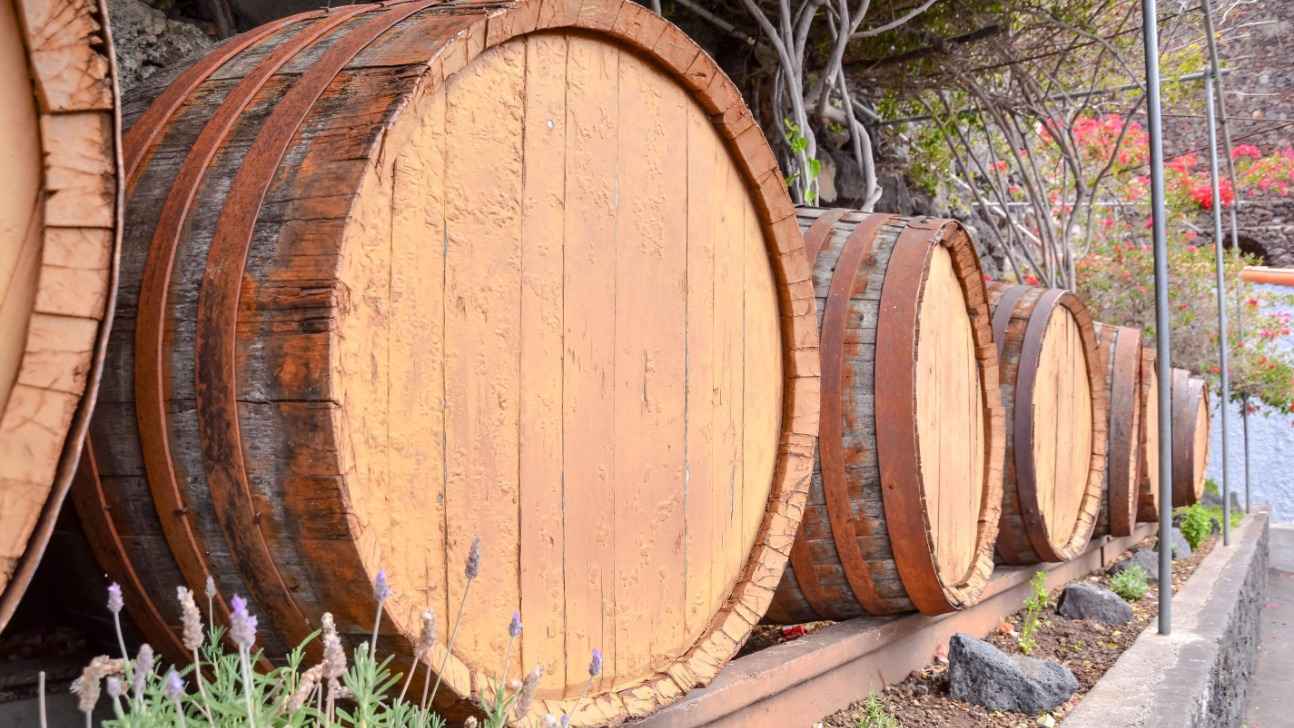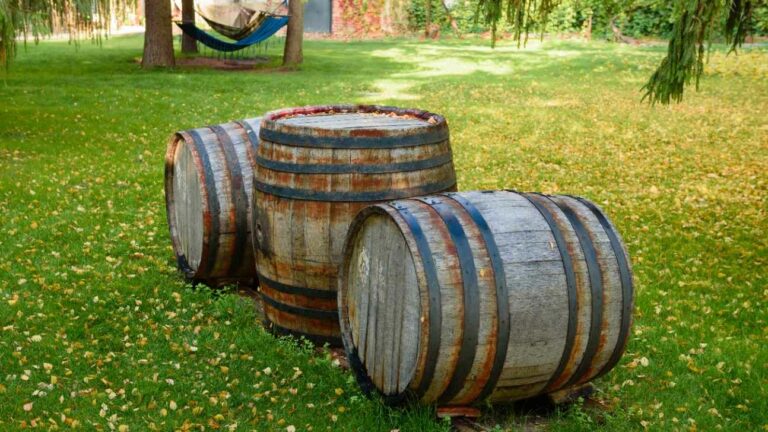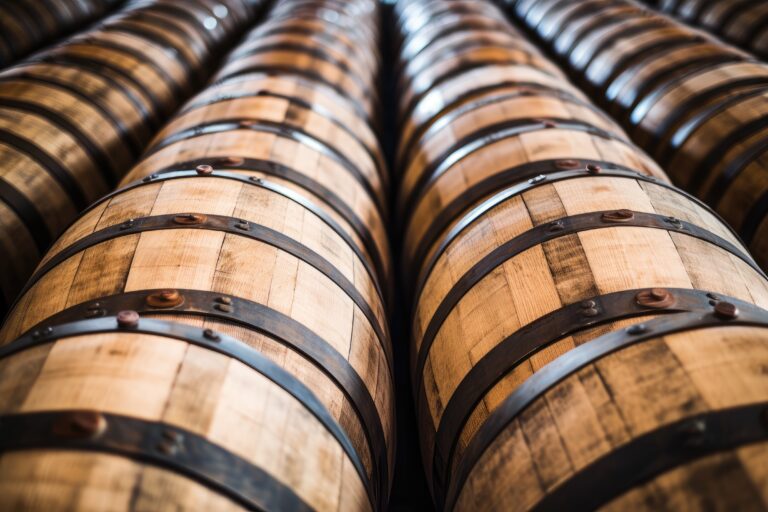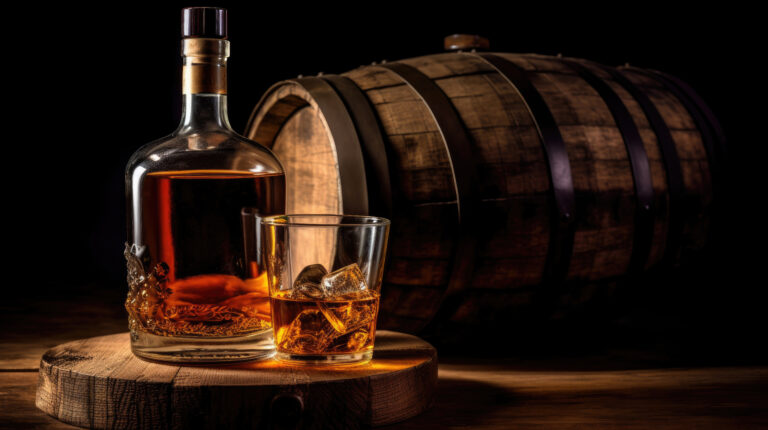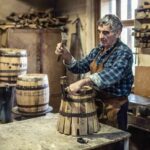Ever wonder what gives whiskey its distinctive character? The answer is deeply rooted in the oak barrels used during its aging process. For centuries, these wooden casks have been essential for mellowing and flavoring whiskey maturation. While the convenience of stainless steel vats might seem appealing, they simply can’t replicate the unique flavors and aromas imparted by oak aging. However, these whiskey barrels come at a significant cost. Barrel costs represent a substantial portion of a distillery’s budget, directly influencing the final retail price you see on the shelf. Distillers face a crucial decision: balancing the desirable qualities of oak, like richer taste and higher quality, against the considerable economic costs. For us consumers, understanding how these barrels shape what’s in our glass can help us appreciate – and maybe justify – that price tag. This is the story of whiskey barrel economics.
The Steep Price of Oak Barrels
Oak barrels don’t come cheap. To properly age whiskey, distillers need high-quality oak casks, and these come with a hefty price tag.
The journey of an oak barrel begins decades before it ever cradles a drop of whiskey. Oak trees require significant time to mature, developing the crucial wood compounds that will eventually lend their flavor to the spirit. Once harvested, the wood undergoes a meticulous crafting process to become a barrel. This includes toasting and charring the interior to specific levels, each influencing the final flavor profile. All in all, producing a single oak barrel can easily cost upwards of $500 to $1000 or even more.
Considering that many distilleries age thousands of barrels simultaneously, often for several years, the total investment in oak barrels quickly becomes substantial. Yet, for most distillers, the unique benefits of oak aging far outweigh these considerable costs.
Oak barrels are the key to those sought-after flavors like vanilla, caramel, and spice that consumers expect in a well-aged whiskey. The oak also imparts that characteristic amber hue. Without oak aging, whiskey would be a clear, harsh spirit, lacking depth, complexity, and nuance.
While alternatives like stainless steel might seem more economical, they simply cannot replicate the intricate chemical reactions that occur between the whiskey and the oak. For true whiskey drinkers, nothing compares to the rich, multi-layered flavor that only oak-aged whiskey can deliver.
So, while oak barrels represent a significant expense, distillers view them as a necessary investment in producing a premium product. The costs are high, but so are the potential rewards when customers are willing to pay a premium for a complex, oak-aged spirit. For both distillers and drinkers, the benefits of oak aging are generally considered well worth the price.
Why Oak Barrels Command Such a High Price
So, why are oak barrels so expensive? The answer boils down to fundamental economics: supply and demand. Oak trees require a long time to mature before they can be harvested, and producing high-quality whiskey barrels demands a specific type of oak known for its tight grain and distinctive flavor-imparting qualities.
The most highly regarded oak for barrel making comes from specific forests in the United States, France, and Eastern Europe. These oaks contribute desirable notes of butterscotch, vanilla, and spice that whiskey makers highly value. However, with the recent surge in demand for premium whiskey, the supply of this top-tier oak hasn’t kept pace. Given that oak trees can take anywhere from 50 to 100 years to reach full maturity, significantly increasing the supply is a long-term challenge.
Adding to the limited supply is the labor-intensive nature of barrel production. The oak must be carefully cut, seasoned (aged), shaped into staves by skilled coopers, and then meticulously assembled, toasted, and charred to precise specifications. The expertise and time of these craftsmen come at a cost.
Then there’s the significant opportunity cost of capital. Tying up substantial funds in barrels for 3 to 10 years as the whiskey undergoes its aging process represents a considerable upfront investment. This capital could otherwise be used for other business operations.
Of course, for the whiskey maker, the undeniable benefits of oak barrels often justify these costs. Oak barrels contribute color, flavor, aroma, and a smooth texture that define the distinctive character of aged spirits. Consumers are willing to pay a premium for the intricate flavors and bouquet that oak-barrel aging provides.
Therefore, while oak barrels are undoubtedly pricey, they play an indispensable role in producing a premium product. For both the whiskey maker and the discerning consumer, the benefits of oak are generally considered a worthwhile investment. The costs associated with oak are simply the price of crafting an artisanal, world-class spirit.
Factors Influencing Barrel Prices
The costs associated with oak barrels have a direct and significant impact on the final price of whiskey. Several key factors determine how much distilleries ultimately pay for these essential vessels:
Availability of Oak
The overall availability of oak suitable for barrel making is a crucial factor. This depends on the annual harvesting and milling rates. As global demand for whiskey barrels rises, the price of raw oak naturally follows suit. Distilleries are compelled to pay higher prices to secure the necessary oak for their barrel production.
Location of Oak Forests
The geographical origin of the oak trees and where they are milled also influences prices. For instance, oak sourced from forests within the U.S., such as Kentucky or Minnesota, might be more cost-effective than oak imported from France or Eastern Europe due to lower transportation expenses. However, some distilleries prioritize the unique flavor profiles imparted by oak from specific regions and are willing to absorb the higher costs associated with it.
Type of Oak
The specific species of oak utilized, such as American white oak or European oak, dictates the quantity and type of aromatic compounds and flavors transferred to the whiskey. Barrels crafted from oak that yields more desirable flavors often command a higher price. For example, French oak barrels sourced from the Limousin or Tronçais forests are highly coveted for their subtle flavor contributions and thus carry a premium.
Quality and Toast Level
Higher quality oak and barrels that have undergone precise toasting to achieve specific flavor profiles are more expensive to produce. The level of toast, ranging from light to heavy char, directly influences the intensity of the oak’s flavor impact. Heavily toasted or charred barrels typically incur higher costs due to the additional handling and specialized skills required in their production.
While the costs associated with oak barrels are substantial, the resulting benefits for distilleries in producing a premium, aged whiskey are generally considered a worthwhile investment. The porous nature of the oak barrel allows for a gradual interaction with oxygen, which mellows the whiskey. Furthermore, the natural compounds within the oak impart distinctive aromas and tastes. All these factors converge to create a final whiskey that commands a higher price point, ultimately making the economics of oak barrels a viable equation for quality spirits.
How Barrels Shape the Flavor Profile
The barrels employed to age whiskey exert a profound influence on its ultimate flavor profile. These oak casks are far more than mere storage containers; they actively transform the whiskey’s taste through a complex process known as maturation.
Oak and Tannins
Oak barrels contain natural chemical compounds called tannins, which are gradually released into the whiskey as it ages. These compounds contribute notes of vanilla, caramel, and spice. Tannins also interact with other components within the spirit, contributing to its color development. The longer the whiskey ages, the more tannins are extracted, often leading to darker and sometimes subtly smoky flavor nuances.
Toast Level
Before a barrel is ready for use, its interior undergoes a toasting or charring process. The intensity of this toasting significantly impacts how quickly tannins and other flavor compounds are imparted to the whiskey. Lightly toasted barrels release these compounds more slowly, while heavily charred barrels lead to a more rapid infusion. Many distillers strategically utilize a combination of barrel toast levels to build complexity in their whiskeys.
Previous Contents
A significant aspect of barrel economics and flavor development is the practice of reusing barrels. For instance, bourbon barrels, having already aged bourbon, often impart notes of vanilla and caramel to subsequent spirits. Similarly, port or sherry casks can lend fruity and nutty characteristics. Some distilleries reuse barrels multiple times, while others prioritize the more intense impact of first-use barrels.
Location
Environmental factors such as temperature and humidity within the aging warehouse also play a crucial role in how quickly a whiskey matures and develops its flavor. Colder temperatures tend to slow down the interaction between the whiskey and the oak, while warmer conditions accelerate the process. Higher humidity levels can also influence the rate of maturation. Many distillers strategically leverage local climate conditions to create unique characteristics in their products.
While oak barrels represent a considerable expense, the unique flavors and aromas they impart to whiskey are truly irreplaceable. By carefully balancing the use of new and used barrels, varying toast levels, and considering local environmental conditions, distillers can craft distinctive and award-winning spirits. The costs associated with high-quality oak barrels are ultimately considered a worthwhile investment for both producers and consumers who appreciate the resulting complexity and depth of flavor.
The Benefits of Aging Whiskey in Oak
Aging whiskey in charred oak barrels offers several key benefits that significantly enhance its flavor and aroma profile.
Oak Adds Flavor
The oak barrels themselves impart a distinctive array of flavors to the whiskey as it matures. Natural compounds present in the wood, such as lignin, break down and are absorbed by the whiskey, contributing notes of vanilla, caramel, and spice. The charred interior of the barrels also contributes a subtle, yet often desirable, smoky undertone.
Oak Softens the Whiskey
During the aging process, the whiskey extracts other compounds from the oak, including tannins, which help to round out any harsh edges and create a smoother, more mellow flavor. The sharper, grainier notes often present in newly distilled whiskey gradually fade over time through this interaction with the oak.
Oak Changes the Color
The characteristic amber hue of whiskey is a direct result of its aging in oak barrels. As the whiskey interacts with the wood, compounds are extracted that gradually darken the spirit from its initial clear state to shades of gold and eventually deep brown. The longer the aging period, the richer and darker the color typically becomes.
Oak Allows for Evaporation
Since oak barrels are not completely airtight, a small percentage of the whiskey naturally evaporates over time. This phenomenon is poetically known as the “angel’s share.” While it represents a loss in volume, this evaporation process actually concentrates the remaining whiskey, intensifying its existing flavor and aroma compounds. The specific climate and humidity levels of the aging warehouse significantly influence the rate of the angel’s share and the final characteristics of the whiskey.
Oak Creates Variety
No two oak barrels are exactly alike, and this inherent variability leads to subtle differences in the qualities they impart to the whiskey. Factors such as the specific type of wood (American vs. French oak), the barrel’s previous use (aging wine or sherry), the level of char, and even the barrel’s position within the aging warehouse all contribute to these nuanced flavor variations. Master distillers often skillfully blend whiskey from multiple barrels to achieve consistency and develop distinctive flavor profiles for their brand.
While the process of aging whiskey in oak barrels certainly involves costs such as time, storage space, and the loss due to evaporation, the benefits of mellowing and enhancing the spirit are undeniable and essential for crafting a full-flavored, well-rounded product. The distinctive qualities that oak aging provides are virtually impossible to replicate through other means, giving whiskey much of its complex character and enduring appeal.
Bourbon vs. Scotch: How Regulations Impact Barrel Use
Both bourbon and Scotch whiskies undergo aging in oak barrels, but the specific regulations governing barrel use differ significantly between these two iconic spirits. Notably, bourbon barrels are legally required to be used only once, while Scotch barrels are frequently reused.
New Oak Only
According to U.S. law, bourbon must be aged in new, charred oak barrels. Distillers are permitted to use a barrel only once for the maturation of bourbon. Following this initial use, these barrels are often sold to age other spirits or are repurposed to produce barrel-aged products like bourbon barrel-aged beer. While the requirement of using fresh barrels for each batch of bourbon adds to the production costs for distillers, it is a key factor in developing the bold vanilla and caramel flavors that are characteristic of bourbon.
Barrel Reuse Allowed
In contrast, the regulations governing Scotch whisky production do not impose any restrictions on the reuse of barrels. Scotch distillers commonly utilize barrels that have previously been used to age bourbon or sherry. Reusing barrels offers a cost-saving advantage for Scotch producers, as they can extract multiple uses from each barrel. However, with each subsequent use, the amount of flavor extracted from the wood diminishes. Scotch aged in used barrels tends to develop darker, spicier notes that are influenced by the previous spirit the barrel held.
Maturation
The types of barrels employed have a substantial impact on how these whiskies mature and develop their unique flavor profiles. The fresh, charred oak barrels used for bourbon lead to a faster extraction of lactones, which contribute notes of vanilla, coconut, and caramel. The practice of reusing barrels for Scotch means that compounds like vanillin are often already depleted, allowing other flavors such as dried fruit, nuts, and warm spice to become more prominent.
Ultimately, both bourbon and Scotch owe their distinctive characteristics to the crucial process of barrel maturation. While the specific regulations regarding barrel use differ, the fundamental interaction between the spirit and the wood is what shapes the unique flavor profiles of these globally celebrated whiskies. Distillers skillfully manipulate variables such as barrel type, age, char level, and previous use to craft exceptional drams from around the world.
Strategies Distillers Employ to Mitigate Barrel Costs
As the global demand for aged whiskey has surged, distilleries have had to become increasingly innovative in their approaches to managing production costs. Given that barrels represent one of the most significant expenses in the whiskey aging process, any effective strategies to reduce these costs while maintaining product quality are highly valuable. Here are several key approaches that distillers commonly utilize:
Reusing Barrels
A common practice is for distilleries to refill used barrels that have already aged one batch of whiskey with a subsequent batch. While the barrel will impart less intense flavor and color to the second batch, it is still a more cost-effective option than purchasing a new barrel. Some distillers will even re-char or re-toast the interior of these used barrels to rejuvenate the oak and intensify its flavor-imparting capabilities before refilling them.
Utilizing Oak Components
Instead of relying solely on whole barrels, some distillers incorporate oak components directly into the aging whiskey. This can include adding oak staves, wood chips, or even oak extracts to the spirit as it ages in a neutral vessel like a stainless steel tank. This method can reduce the overall volume of whiskey lost to evaporation compared to aging in whole barrels. Additionally, these wood components offer a more concentrated source of oak flavor, potentially accelerating the aging process. However, some critics argue that this approach can result in a final product that lacks the complexity achieved through traditional barrel aging.
Blending Aged and Unaged Whiskey
Another cost-saving strategy involves blending a smaller proportion of aged whiskey with unaged spirit, often referred to as “new make,” to create a blended whiskey product. The aged component contributes the desired oak and vanilla notes, while the unaged spirit provides a distinct cereal character. By using a lower ratio of aged to unaged whiskey, distillers can significantly reduce their barrel costs while still offering a palatable product. However, it’s important to note that regulations in many regions dictate the minimum aging requirements for certain labeled whiskies, such as “Kentucky bourbon.”
Employing Smaller Barrels
Aging whiskey in smaller barrels, with capacities ranging from 5 to 30 gallons, increases the surface area of wood in contact with the spirit relative to the volume. This accelerated interaction with the oak can allow the whiskey to achieve an “aged” flavor profile in a shorter timeframe. While this method necessitates more frequent barreling and unbarreling, the reduced aging time can translate to substantial cost savings in terms of storage and capital tied up in inventory. However, a potential downside of using smaller barrels is a higher rate of oxidation and evaporation due to the increased surface area exposure.
By strategically leveraging these innovative techniques, distillers can navigate the delicate balance between meeting the growing demand for aged whiskey and the economic realities of the industry. While traditional barrel aging is still widely regarded as the gold standard for producing premium spirits, these alternative approaches offer greater flexibility and a wider range of price points for consumers.
The Future Landscape of Oak Barrels in Whiskey Production
For centuries, the use of oak barrels has been an indispensable element of whiskey production. However, some distillers are now exploring alternative materials and methodologies. While oak barrels are deeply ingrained in tradition and contribute the distinctive flavor profiles that consumers have come to expect, they also represent a significant cost factor. As the global demand for whiskey continues its upward trajectory, the economics of barrel aging may well necessitate adaptation within the industry.
Oak barrels, particularly those previously used for bourbon, are becoming increasingly expensive to procure and maintain. The initial investment for a standard 53-gallon barrel can range from several hundred dollars, and after a limited number of uses, the barrel must either be discarded or undergo a costly reconditioning process. Reconditioning involves thorough cleaning, repairing any leaks, and re-charring the interior to reactivate the wood’s flavor-imparting properties. This additional expense and labor further contribute to the already lengthy aging process required for premium whiskeys.
Alternative materials, such as stainless steel, offer greater economic efficiency and ease of maintenance, although they do not impart the complex flavors associated with oak. Some distillers are experimenting with aging whiskey primarily in stainless steel tanks, with a final finishing period in oak barrels to impart the desired wood notes while reducing the overall time the spirit spends in the more expensive oak. Others are exploring the use of various types of wood chips and staves in conjunction with steel tanks to create customized wood-infused flavors at a lower cost.
As global demand for whiskey, particularly for premium aged varieties, continues to rise, the supply of high-quality oak barrels will likely face increasing pressure. Distillers may find themselves contending with higher prices and longer lead times for acquiring barrels, prompting them to explore alternative sourcing options or even invest in establishing their own cooperages to ensure a consistent supply. For smaller craft distilleries operating with tighter profit margins, these escalating barrel costs could pose a significant challenge to their business models.
The future role of oak in whiskey production hinges on a delicate balance between upholding tradition, navigating economic realities, and embracing innovation. While oak barrel aging is intrinsically linked to the distinctive flavor profiles of many beloved whiskies, the spiraling costs and potential supply constraints may gradually lead to the adoption of more efficient methods. In such a scenario, oak might be utilized more strategically, perhaps primarily for finishing and accentuating flavors rather than serving as the sole aging vessel. Distillers will need to carefully tread the line between controlling costs and preserving the quality and reputation of their craft. Ultimately, consumers’ willingness to accept some degree of deviation from traditional aging practices may determine whether oak remains the undisputed king of whiskey maturation or gradually evolves into a cost-prohibitive relic.
Whiskey Barrel Economics FAQs
Oak barrels represent a substantial cost for whiskey producers, yet they also provide significant benefits that contribute to the final product’s quality and market value. Here are some key economic factors to consider regarding oak barrels:
Initial Cost
High-quality oak barrels can range in price from $500 to $1000 or even more per barrel. For a large distillery, which may utilize over 100,000 barrels at any given time, this represents an initial capital investment in the tens of millions of dollars.
Useful Life
Oak barrels typically have a useful lifespan of around 3 to 5 years before their ability to impart significant flavor and aroma compounds to the whiskey diminishes. Some distilleries may choose to reuse barrels a couple of times to maximize their initial investment.
Maturation
As whiskey ages within oak barrels, it undergoes a crucial maturation process, absorbing desirable flavors and aromas from the wood. This interaction profoundly impacts the final taste, aroma, and overall quality of the spirit and is a defining characteristic of premium whiskey.
Angel’s Share
During the aging process in oak barrels, whiskey producers experience a natural loss of volume due to evaporation through the porous wood. This “angel’s share” typically amounts to 2-4% per year. While this reduces the final quantity of whiskey available for bottling and sale, it also concentrates the remaining spirit, enhancing its flavor complexity.
Cost vs. Benefit
For the majority of distilleries, the multifaceted benefits of oak barrel maturation—including enhanced quality, distinctive taste, and elevated brand prestige—generally outweigh the considerable costs associated with purchasing and maintaining the barrels. Oak barrels are instrumental in producing a premium product that commands a higher market price, ultimately offsetting the initial investment.
However, for smaller craft distilleries operating with tighter financial margins, the economics of oak barrels can present a significant balancing act. Some of these distilleries are exploring alternative barrel types, sizes, and char levels in an effort to achieve desirable oak flavors while operating within a more constrained budget.
In conclusion, oak barrels are inextricably linked to the tradition and quality of whiskey. Despite their expense, they play a transformative role in converting raw distillate into an exceptional finished product that is highly valued worldwide. For most whiskey makers and connoisseurs alike, the benefits derived from oak barrels far surpass the associated costs.
Final Thoughts
So there you have it – a deeper dive into the intricate world of whiskey barrel economics. Oak barrels are undeniably integral to the creation of that delicious, amber-hued spirit we all know and appreciate. While the process of aging whiskey in these wooden casks represents a substantial financial undertaking for distillers, the unique flavor and aroma compounds imparted to the spirit are simply unattainable through any other method. The next time you find yourself savoring a glass of bourbon, rye, or Scotch, take a moment to consider the significant time, financial investment, and skilled craftsmanship that went into producing the liquid in your glass. Appreciate the delicate interplay of science and art. Savor the nuanced notes of vanilla, spice, and charred wood. And perhaps, raise your glass in a silent toast to the humble, hardworking barrel that made it all possible.
